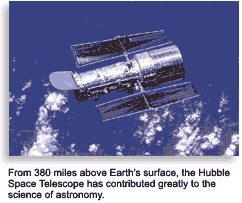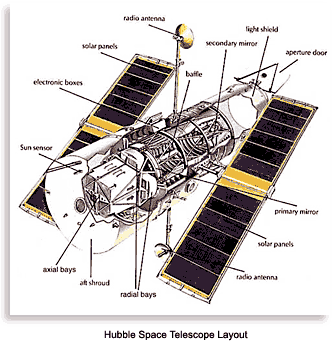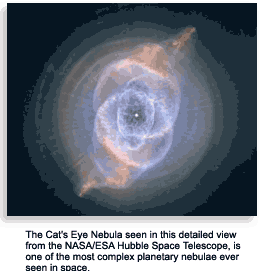Even on the clearest night, the atmosphere of the Earth distorts starlight, which limits the ability of earthbound telescopes to focus on small or faint objects. It has long been the dream of astronomers to place a telescope in space, free from such constraints. The Hubble Space Telescope (HST), named for American astronomer Edwin Hubble, was the realization of that ambition.
 German scientist Hermann Oberth, whose achievements inspired rocket scientist Wernher von Braun, proposed the construction of an observatory in space as early as 1923. Instruments carried by early rockets in the 1940s and 1950s produced evidence that better observations were indeed possible.
An astronomer at Mount Wilson Observatory, Hubble had, with the world’s largest telescope at the time, discovered galaxies outside the Milky Way. He was perhaps the greatest astronomer of the 20th century.
In 1962, a study group of the National Academy of Sciences recommended that the National Aeronautics and Space Administration (NASA), established just four years earlier, undertake the development of a large space telescope as one of its long-term objectives. Similar recommendations were made in 1965 and 1969. NASA launched two Orbiting Astronomical Observatories, one in 1968 and one in 1972. The excellent results provided a compelling argument for an even larger instrument.
When NASA received authorization to develop the Space shuttle in 1972, a large space telescope became a real possibility. In 1973, NASA pulled together a team to design the telescope and its instruments. That group grew to 60 in 1977, the same year Congress authorized funds for the project.
The Marshall Space Flight Center was directed to develop and build the telescope. Goddard Space Flight Center was given the task of developing scientific instruments and the ground control center. The European Space Agency, which had been involved since 1975, was assigned the solar arrays and one scientific instrument. The Space Telescope Science Institute at John Hopkins University performed the science planning for the telescope while Space Telescope Operations Control Center, located at Goddard, provided ground control for the telescope.
German scientist Hermann Oberth, whose achievements inspired rocket scientist Wernher von Braun, proposed the construction of an observatory in space as early as 1923. Instruments carried by early rockets in the 1940s and 1950s produced evidence that better observations were indeed possible.
An astronomer at Mount Wilson Observatory, Hubble had, with the world’s largest telescope at the time, discovered galaxies outside the Milky Way. He was perhaps the greatest astronomer of the 20th century.
In 1962, a study group of the National Academy of Sciences recommended that the National Aeronautics and Space Administration (NASA), established just four years earlier, undertake the development of a large space telescope as one of its long-term objectives. Similar recommendations were made in 1965 and 1969. NASA launched two Orbiting Astronomical Observatories, one in 1968 and one in 1972. The excellent results provided a compelling argument for an even larger instrument.
When NASA received authorization to develop the Space shuttle in 1972, a large space telescope became a real possibility. In 1973, NASA pulled together a team to design the telescope and its instruments. That group grew to 60 in 1977, the same year Congress authorized funds for the project.
The Marshall Space Flight Center was directed to develop and build the telescope. Goddard Space Flight Center was given the task of developing scientific instruments and the ground control center. The European Space Agency, which had been involved since 1975, was assigned the solar arrays and one scientific instrument. The Space Telescope Science Institute at John Hopkins University performed the science planning for the telescope while Space Telescope Operations Control Center, located at Goddard, provided ground control for the telescope.
 A decade was required to build the telescope. The mirror was completed in 1981, science instruments were delivered to NASA for integration in 1983, the optical assembly was ready in 1984, and the entire telescope was put together by 1985.
Delivery to space, however, was set back by the Challenger disaster in January, 1986. That was the year HST was supposed to be put into orbit, but due to delays in the shuttle program, it wasn't carried aloft until Mission STS-31 was launched on April 24, 1990. The crew of the space shuttle Discovery placed it in Earth's orbit and observations began.
It soon became evident that something was awry. It seems that the main mirror was too flat near the edge, an error equal to about 1/50th the width of a human hair. Images of faint objects were blurred. However, images of relatively bright objects greatly exceeded anything that telescopes on earth had obtained, and HST could make ultraviolet and spectrographic observations with instruments not affected by the mirror's aberration. Spectrographic observations involve an instrument that splits or disperses light from a spatial object into its component wavelengths so that it can be recorded and then analyzed.
The telescope could not be corrected, but it was possible to design corrective instruments, which have been compared to eyeglasses for humans, to compensate for the errors produced by the mirror. It also was fortunate that HST had been designed with shuttle maintenance flights in mind. Individual components could be removed as modules and replaced with other instruments occupying the same dimensions.
The task of upgrading HST would be the most challenging ever assigned to a team of astronauts. Shuttle crew members Richard O. Covey, commander; Kenneth D. Bowersox, pilot; F. Story Musgrave, payload commander; Kathryn C. Thornton, mission specialist 1; European astronaut Claude Nicollier, mission specialist 2; Jeffrey A. Hoffman, mission specialist 3; and Thomas D. Akers, mission specialist 5, trained for a year and a half and learned how to operate 100 tools. The shuttle Endeavour conveyed them to HST in December 1993 and, with millions watching on live television, performed the necessary upgrades.
Five weeks of testing followed. When the telescope was declared fit for service, the first images were sent back to Earth. In the years that followed, Hubble's imaging and spectroscopy have resulted in numerous scientific achievements. They include calculating the changing rate of expansion of the universe as well as detailed studies of forming galaxies, black holes, galaxy hosts of gamma-ray bursts and quasars, active galactic nuclei, protostars, planetary atmospheres, and the interstellar and intergalactic media.
A decade was required to build the telescope. The mirror was completed in 1981, science instruments were delivered to NASA for integration in 1983, the optical assembly was ready in 1984, and the entire telescope was put together by 1985.
Delivery to space, however, was set back by the Challenger disaster in January, 1986. That was the year HST was supposed to be put into orbit, but due to delays in the shuttle program, it wasn't carried aloft until Mission STS-31 was launched on April 24, 1990. The crew of the space shuttle Discovery placed it in Earth's orbit and observations began.
It soon became evident that something was awry. It seems that the main mirror was too flat near the edge, an error equal to about 1/50th the width of a human hair. Images of faint objects were blurred. However, images of relatively bright objects greatly exceeded anything that telescopes on earth had obtained, and HST could make ultraviolet and spectrographic observations with instruments not affected by the mirror's aberration. Spectrographic observations involve an instrument that splits or disperses light from a spatial object into its component wavelengths so that it can be recorded and then analyzed.
The telescope could not be corrected, but it was possible to design corrective instruments, which have been compared to eyeglasses for humans, to compensate for the errors produced by the mirror. It also was fortunate that HST had been designed with shuttle maintenance flights in mind. Individual components could be removed as modules and replaced with other instruments occupying the same dimensions.
The task of upgrading HST would be the most challenging ever assigned to a team of astronauts. Shuttle crew members Richard O. Covey, commander; Kenneth D. Bowersox, pilot; F. Story Musgrave, payload commander; Kathryn C. Thornton, mission specialist 1; European astronaut Claude Nicollier, mission specialist 2; Jeffrey A. Hoffman, mission specialist 3; and Thomas D. Akers, mission specialist 5, trained for a year and a half and learned how to operate 100 tools. The shuttle Endeavour conveyed them to HST in December 1993 and, with millions watching on live television, performed the necessary upgrades.
Five weeks of testing followed. When the telescope was declared fit for service, the first images were sent back to Earth. In the years that followed, Hubble's imaging and spectroscopy have resulted in numerous scientific achievements. They include calculating the changing rate of expansion of the universe as well as detailed studies of forming galaxies, black holes, galaxy hosts of gamma-ray bursts and quasars, active galactic nuclei, protostars, planetary atmospheres, and the interstellar and intergalactic media.
 In addition to the initial repair mission, Hubble has been serviced twice more by shuttle flights. As it approaches the end of its originally intended service life of 15 years, controversy has surrounded the economics of prolonging its mission. Cancellation of the 2005-2006 time frame of the latest service mission to Hubble was due to recent fears for astronaut safety spurred by the February 2003 Shuttle Columbia tragedy. Because planning and development for that mission was so far along and the potential benefits from Hubble's latest upgrades were so great, NASA did not want to scrap the mission entirely, and therefore decided to consider a fully robotic repair mission. With another service mission calculated to cost a billion dollars, a high-stakes fight over the budget for Hubble seemed inevitable. A mission, if approved, might occur around mid-2007 or early 2008.
In addition to the initial repair mission, Hubble has been serviced twice more by shuttle flights. As it approaches the end of its originally intended service life of 15 years, controversy has surrounded the economics of prolonging its mission. Cancellation of the 2005-2006 time frame of the latest service mission to Hubble was due to recent fears for astronaut safety spurred by the February 2003 Shuttle Columbia tragedy. Because planning and development for that mission was so far along and the potential benefits from Hubble's latest upgrades were so great, NASA did not want to scrap the mission entirely, and therefore decided to consider a fully robotic repair mission. With another service mission calculated to cost a billion dollars, a high-stakes fight over the budget for Hubble seemed inevitable. A mission, if approved, might occur around mid-2007 or early 2008.